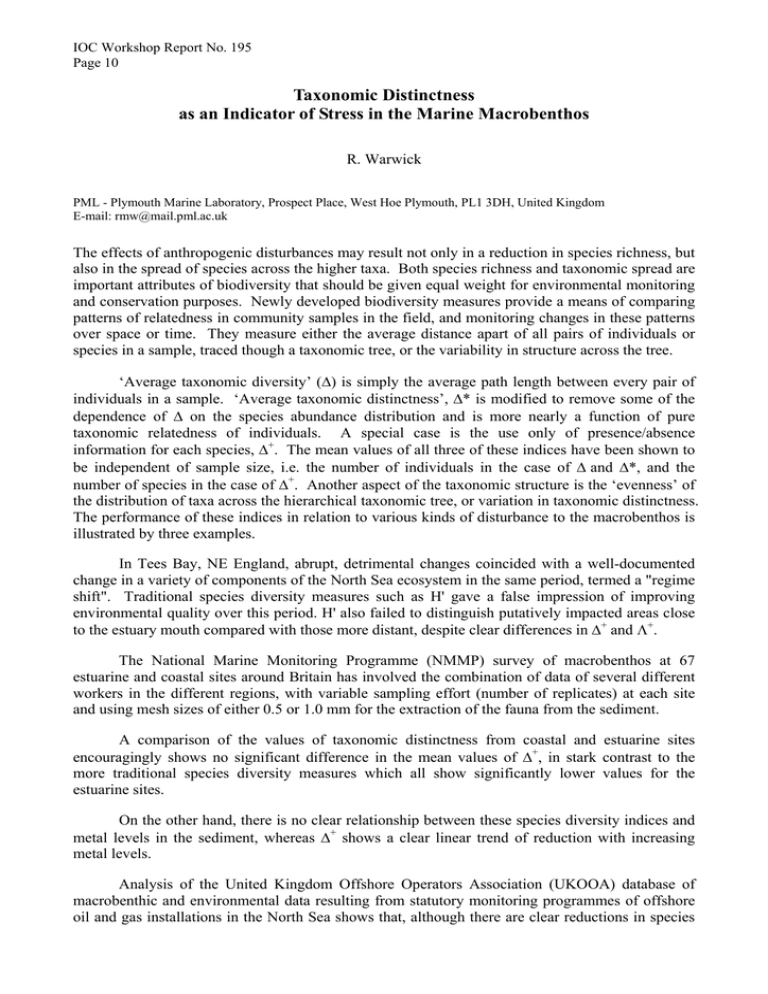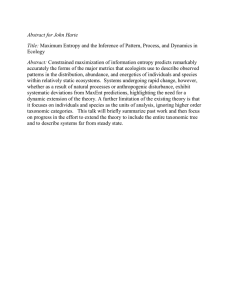Taxonomic Distinctness as an Indicator of Stress in the Marine Macrobenthos
advertisement

IOC Workshop Report No. 195 Page 10 Taxonomic Distinctness as an Indicator of Stress in the Marine Macrobenthos R. Warwick PML - Plymouth Marine Laboratory, Prospect Place, West Hoe Plymouth, PL1 3DH, United Kingdom E-mail: rmw@mail.pml.ac.uk The effects of anthropogenic disturbances may result not only in a reduction in species richness, but also in the spread of species across the higher taxa. Both species richness and taxonomic spread are important attributes of biodiversity that should be given equal weight for environmental monitoring and conservation purposes. Newly developed biodiversity measures provide a means of comparing patterns of relatedness in community samples in the field, and monitoring changes in these patterns over space or time. They measure either the average distance apart of all pairs of individuals or species in a sample, traced though a taxonomic tree, or the variability in structure across the tree. ‘Average taxonomic diversity’ (∆) is simply the average path length between every pair of individuals in a sample. ‘Average taxonomic distinctness’, ∆* is modified to remove some of the dependence of ∆ on the species abundance distribution and is more nearly a function of pure taxonomic relatedness of individuals. A special case is the use only of presence/absence information for each species, ∆+. The mean values of all three of these indices have been shown to be independent of sample size, i.e. the number of individuals in the case of ∆ and ∆*, and the number of species in the case of ∆+. Another aspect of the taxonomic structure is the ‘evenness’ of the distribution of taxa across the hierarchical taxonomic tree, or variation in taxonomic distinctness. The performance of these indices in relation to various kinds of disturbance to the macrobenthos is illustrated by three examples. In Tees Bay, NE England, abrupt, detrimental changes coincided with a well-documented change in a variety of components of the North Sea ecosystem in the same period, termed a "regime shift". Traditional species diversity measures such as H' gave a false impression of improving environmental quality over this period. H' also failed to distinguish putatively impacted areas close to the estuary mouth compared with those more distant, despite clear differences in ∆+ and Λ+. The National Marine Monitoring Programme (NMMP) survey of macrobenthos at 67 estuarine and coastal sites around Britain has involved the combination of data of several different workers in the different regions, with variable sampling effort (number of replicates) at each site and using mesh sizes of either 0.5 or 1.0 mm for the extraction of the fauna from the sediment. A comparison of the values of taxonomic distinctness from coastal and estuarine sites encouragingly shows no significant difference in the mean values of ∆+, in stark contrast to the more traditional species diversity measures which all show significantly lower values for the estuarine sites. On the other hand, there is no clear relationship between these species diversity indices and metal levels in the sediment, whereas ∆+ shows a clear linear trend of reduction with increasing metal levels. Analysis of the United Kingdom Offshore Operators Association (UKOOA) database of macrobenthic and environmental data resulting from statutory monitoring programmes of offshore oil and gas installations in the North Sea shows that, although there are clear reductions in species IOC Workshop Report No. 195 Page 11 diversity as a result of oil and gas activities, there are also reductions in the taxonomic spread of species which would not have been detected if these novel taxonomic indices had not been applied. These effects are not confined to the immediate vicinity of the rigs but extend out as far as 10 km, which is the maximum distance sampled in most of the surveys. Since taxonomic spread is more directly related to functional diversity than is species richness, these novel measures might in fact be more important to consider in terms of the conservation of ecosystem functioning. Significant effects of oil and gas activity were detected in taxonomic distinctness indices based on simple nonquantitative species lists, and the use of such indices for monitoring purposes could result in a considerable saving in time, effort and cost. Key References Warwick, R.M., Clarke, K.R., 2001. Practical measures of marine biodiversity based on relatedness of species. Oceanography and Marine Biology: an Annual Review, 39: 207-231. Warwick, R.M., Ashman, C.M., Brown, A.R., Clarke, K.R., Dowell, B., Hart, B., Lewis, R.E., Shillabeer, N., Somerfield, P.J., Tapp, J.F., 2002. Inter-annual changes in the biodiversity and community structure of the macrobenthos in Tees Bay and the Tees estuary, UK, associated with local and regional environmental events. Marine Ecology Progress Series, 234: 1-13.





